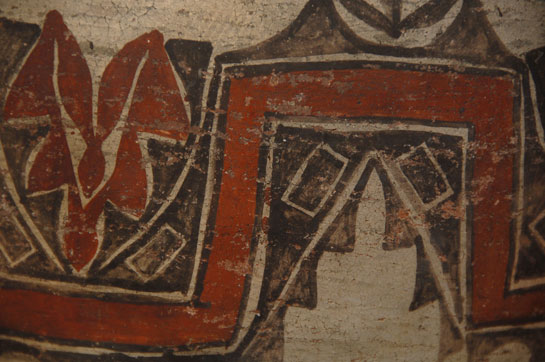Zia Pueblo Trios Polychrome Olla, circa 1850s [SOLD]
+ Add to my watchlist Forward to Friend
- Category: Historic
- Origin: Zia Pueblo, Tsi-ya
- Medium: clay, pigment
- Size: 11-1/4” tall x 12-1/4” diameter
- Item # C3328A SOLD
Typology designations of pueblo pottery have been assigned by noted authorities based on observed changes over decades. At Zia Pueblo, one of the earlier designations is Puname Polychrome (1700-1760) which was followed by the designation San Pablo Polychrome (1760-1820), then Trios Polychrome (1820-1860) and, finally, today's designation of Zia Polychrome (1860-present).
This jar falls between the late San Pablo Polychrome period and the early Trios Polychrome period. It appears to be in the transition period between the two. The vessel body shape has departed from the very globular shape of those of San Pablo Polychrome but the design elements are closer to those of the San Pablo Polychrome than those of Trios Polychrome. The design does not contain any of the capped spiral design elements seen on Trios Polychrome vessels of the entire 19th century. The design on this jar is very close to the style seen in Figure 4.8, a transitional jar from the Larry Frank Collection, circa 1800-1810. (The Pottery of Zia Pueblo by Harlow and Lanmon).
Also, according to Harlow and Lanmon, realistic birds, as seen on the neck of this jar, appeared about 1820. It is believed that birds of the style on this jar with associated floral elements were encouraged by Santa Fe merchants starting in the mid-1800s and blossoming into the late 1800s Trios Polychrome period. Traders had been buying pottery from the pueblos since the 1850s but the real increase occurred with the arrival of the transcontinental train in 1880 which brought tourists and collectors into the area, and, of course, increased production of pottery by the potters.
We feel safe in saying that this jar is a Trios Polychrome from the mid-1800s with design elements related to San Pablo Polychrome of the early 1800s.
Condition: UV examination reveals no repairs or restoration other than one hairline crack at the rim that has been stabilized.
Provenance: from the collection of an Albuquerque gentleman
Recommended Reading: The Pottery of Zia Pueblo by Francis H. Harlow and Dwight P. Lanmon

- Category: Historic
- Origin: Zia Pueblo, Tsi-ya
- Medium: clay, pigment
- Size: 11-1/4” tall x 12-1/4” diameter
- Item # C3328A SOLD
Adobe Gallery Recommended Reading
Adobe Gallery Recommended Items
If you are interested in this item, we would also like to recommend these other related items:



